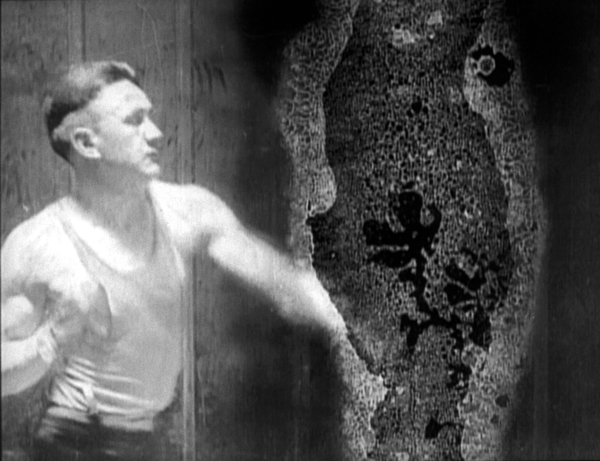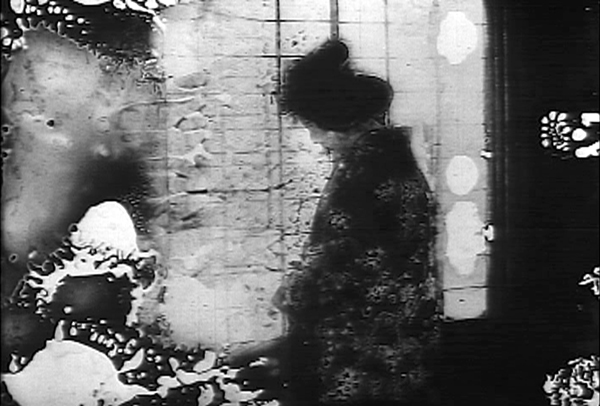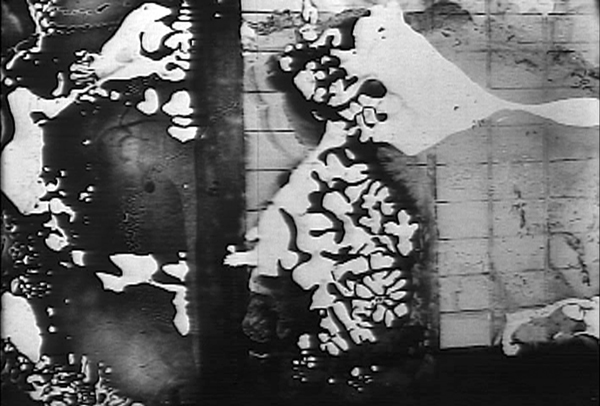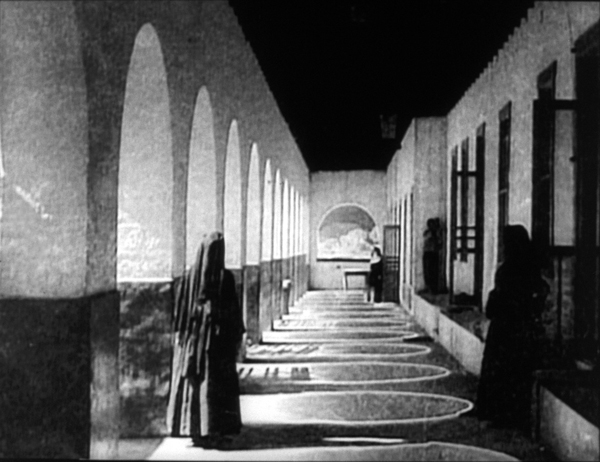For the past twenty years, Bill Morrison has been mining film archives, resurrecting decaying nitrate that would otherwise have been discarded and then editing it into new narratives.
Released in 2002, Decasia helped Morrison reach a wide audience. Tied to a hypnotic score by Michael Gordon, the 67-minute feature explores many levels and meanings of decay, from the physical aspects of nitrate decomposition to the ruminations on nostalgia and memory.
Decasia started out as a commission by the Europaischer Musikmonat for a symphony by composer Michael Gordon, a co-founder of Bang On A Can. Along with artistic director Bob McGrath and visual designer Laurie Olinder, Morrison was a member of Ridge Theatre, which had been staging Bang On A Can operas. The three were commissioned to create a visual component to Gordon’s score.
Morrison found the footage that makes up Decasia in various archives, among them The George Eastman House in Rochester, The Library of Congress, The Museum of Modern Art, and the University of South Carolina Newsfilm Library. Too deteriorated to restore, the nitrate was ready to be junked.
For Morrison, rescuing the films from the scrap heap, turning them from hazardous waste back into art, was one of the redeeming factors of Decasia. “Somehow they’ve managed to be viewed in the 21st century, whereas almost everything else from the silent era is lost,” he said in an interview.
The original films included dramas like Truthful Tulliver, a 1917 Kay-Bee Western starring William S. Hart, and A Tokio Siren, a 1920 melodrama from Universal. Morrison also used nonfiction pieces like Ritchie Trains and Egyptian Dancers, both Fox Movietone newsreels.
The clips show a full range of nitrate damage. Improperly stored, nitrate film can buckle, warp, shrink and tear. The emulsion—a layer containing the photographic image—can pull away from its backing. It can oxidize into spots, blotches, blobs. It can reverse positive and negative images, an effect something like solarization.
And because each frame deteriorates at a different rate, the effects of the decay change as the film is projected. It can pulse, weave or throb. If a reel was damaged in a specific area—by being stored upright on a shelf, for example—the resulting effects could take on their own rhythms, just like a scratch on a phonograph record adds a new beat to the music when it is played.
Morrison’s creative leap was to marshal or corral nitrate decomposition for its aesthetic impact, its sheer beauty. The whirling dervishes in Egyptian Dancers dissolve into abstract patterns, almost like electronic snow on television screens. A boxer in Ritchie Trains battles a blob that threatens to overwhelm the frame.
On one level Decasia is a celebration of decay, a sort of time-lapse look at deterioration, enhanced by Gordon’s austerely minimalist score.
But Decasia is more than an account of physical effects. Morrison’s choice of material—his use of montage and mise-en-scène—adds narrative layers to the footage.
Take the boxer in Ritchie Trains. “That boxer, the image of him fighting an amorphic blob, a great unknown—on the one hand he’s heroic, on the other hand he’s comical. He’s valiantly fighting, but it’s also sort of ironic because you can’t fight forever. Eventually he’s going to be consumed by that blob.”
Morrison can get as darkly existential as you want: “There’s this comic element, none of this amounts to anything because the base on which the emulsion is fighting its battle is giving out, it’s all being done on quicksand.
“We do manage to get things done, but we get them done by being blind to the fact that we’re mortal or finite. We have a very limited time to get anything done at all. And the greatest things are done with the idea that the work is going to continue somehow, that it’s going to be carried on.”
But every second, every frame of Decasia reminds us that loss is imminent, inevitable. In a way the movie is a battle between survival and decay.
“It seemed like the images to choose were ones where the protagonists were somehow engaged in activities where they’re overstepping mortal bounds. That they’re engaged in either religious rapture or love or athletic greatness. Love, rapture, inebriation, some sort of going beyond the normal confines of the everyday experience. And in this reaching beyond, the rug’s being pulled out from under them at the same time.”
“In A Tokio Siren, there’s a shot of a kimono made from a print material. That print motif becomes repeated in the decay, you almost see the same shapes that are on the kimono on the surface of the film. The film is sort of rhyming between the formal disintegration and the content.”
Sometimes Morrison lucked across footage, like a shot of nuns watching students parade across a courtyard, a newsreel outtake.
“I found that in a box on the first day, I said, ‘Well, there’s something here, I’m finding this for a reason. There’s a theme that can be teased out here.’ The original soundtrack on it was pulsating, it also had decay. It was super annoying, just dogs barking and bells ringing.”
Morrison also had to consider the larger narrative formed by the juxtaposition of clips.
“You can’t tell an archivist that these themes are what you’re looking for, but you can say, ‘Let’s see images of that place, or let’s break it down into a subset of films that we know are showing some sort of deterioration.” But simple decay wasn’t enough: Morrison was looking for decomposition that related to the image. The boxer fighting decay, the kimono transformed into a nitrate design.
“I would put things into different bins, according to the decay they had, according to the cycle, and in doing that I discovered that a theme of cruelty to women kept emerging, or defining space through pillars and colonnades. That became synonymous with filmmaking.”
Morrison now works with digital files, but “back in the Decasia days we were making new negatives photochemically” from the decaying footage.
“Certain labs would take the trouble to soak a reel and rewash it, and then I worked with an optical house to rephotograph it frame by frame, adjusting for shrinkage,” he says. “That’s the same thing we do now, except we scan it digitally.”
Morrison tried to keep the original footage intact. “There are such long, sweeping movements that it’s really distracting if you cut away,” he said. He also resisted adjusting the speed of the clips, how many frames per second are shown.
“Digitally it’s so easy,” he said. “You can tell a software program to ‘slow down 59%’ or 81% or whatever, and it will do it automatically. Photochemically sometimes you have to repeat frames, go two-to-one or three-to-one. But the image starts to lose its cinematic quality, it becomes too much like a slide show.”
Morrison cut Decasia to Michael Gordon’s score, “which is almost exclusively how I work. It was difficult because the takes are so long, and that would sometimes dictate whether I put a shot here or there.”
Gordon and Morrison received their commissions at the same time. Morrison showed the composer some of the footage he wanted to work with, while Gordon played part of his score at one point.
“He had very little to say about what I put where, as I had very little to say about what he wrote,” was how the director characterized their collaboration. “When I was editing, I only had a MIDI track. It sounded like a Casio computer rendering of the score, which was very difficult to edit to. I had a full head of hair when I started,” he jokes.
The director used to work on a Steenbeck, a flatbed editing table, a tool he doesn’t miss.
“I’m not a very organized guy. With Final Cut and digital drives, you have a built-in organizational principle. Nothing can get done unless you set up folders and files. And that helps me enormously, because otherwise there would be little rolls of taped-up film all over my house. In fact, that’s how I lived up until this century.”
Despite working so intently with nitrate, Morrison isn’t a romantic about film. But since digital standards are still in flux, he believes that 35mm is still the “Rosetta Stone” for archivists. “There will probably be more nitrate images that are legible in the next century than there are digital ones. It’s a concern, but I also think that what I’m doing can be preserved during my lifetime.”
Morrison admits that he can see a difference between 35mm and digital. “I’m having to accept it [digital],” he says. “And I’m a lot more productive in the digital world. Scanning the nitrate means that I’m saving this spectacular imagery on some level. If somebody wants me to output a 35mm print I can do it through a digital intermediary.”
Starting in 2014, he started offering his films on DCPs, Digital Cinema Packages.
“I changed from film because my projects were being funded by performing arts venues that didn’t have 35 or 16mm projectors, they had video projectors,” he explains. “Decasia‘s out on commercial Blu-ray commercially, and I’ve made Blu-rays of most things I send to festivals. But who knows? Maybe in a few years, DCPs will be passé.”
Morrison visits the Library of Congress three or four times a year to deliver talks and to look over footage.
“I have a unique relationship with a manager there,” he laughs. “George [George R. Willeman, Nitrate Film Vault Manager] sometimes says he’s my enabler. His job description is to get rid of decaying nitrate that might to spread throughout the collection. Or make shelf space, basically. I’m like the worms in mulch.”
Willeman sets aside material that will be de-accessioned on a shelf in a holding vault labeled with Morrison’s name on a Post-It.
“He’s going through stuff, and some of it he’s just going to throw away,” Morrison says. “He’s not going to re-can it, he’s not going to put it back on the shelf. But there’s still something there. And he knows that the only person in the world who would still be interested in that is me.”
Willeman and Mike Mashon (head of the Moving Image Section of the Library of Congress) have even come up with a term for decomposing footage. “They use my name as an adjective, like, ‘Oh, that’s gone all Bill Morrison,'” he laughs.
“Back when the nitrate vaults were in Dayton, Ohio, George found this print of a 1926 film called The Bells by James Young which was redundant. It was a pristine print they were throwing away, but he gave me three rolls that were really spectacular. I ended making Light Is Calling [2004] and The Mesmerist [2003] from those same rolls.”
Much of the material for both Decasia and The Great Flood, a 2013 work that explores Mississippi during the Depression, came from Fox Movietone outtakes stored at the University of South Carolina. Morrison has recently started working with the EYE Institute in the Netherlands.
“I’m like a de facto reclamation team,” Morrison jokes. “That stuff just sits there until somebody says, ‘I want to see that reel on that shelf.’ Then they will bring it out and scan it.”
Morrison’s point is that there is usually no policy to digitize the entirety of an archive’s nitrate holdings.
“I give a presentation about a trove of silent nitrate footage that was found in Dawson City. It was discovered in 1978, restored in 1979, and then it just sat on a shelf.
“Who is looking at this stuff? Who is really taking the time? One reason why I have a relationship with George and Mike is that I’m one of the few people who walk through the door asking, ‘What do you have?’ There simply isn’t much interest in looking through restored footage on a shelf. I think people would much rather search YouTube.”
Morrison’s filmography includes The Great Flood, Outerborough (2005), Spark of Being (2010), The Miners’ Hymns (2011), and Beyond Zero: 1914–1918 (2014). They are available in a 5-disc box set from Icarus and a 3-disc Blu-ray box set from the British Film Institute.
Morrison is a Guggenheim fellow and has received the Alpert Award for the Arts, an NEA Creativity Grant, Creative Capital, and a fellowship from the Foundation for Contemporary Arts. His theatrical projection design has been recognized with two Bessie awards and an Obie Award.






